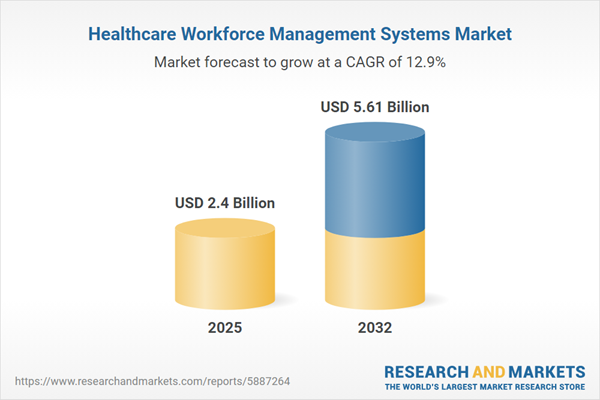Speak directly to the analyst to clarify any post sales queries you may have.
The healthcare workforce management systems market is rapidly evolving as care organizations adapt to new delivery models and digital imperatives. Executive leaders require actionable intelligence to optimize staffing, navigate regulatory shifts, and capture the efficiencies enabled by integrated workforce technologies.
Healthcare Workforce Management Systems Market Snapshot
The Healthcare Workforce Management Systems Market grew from USD 2.13 billion in 2024 to USD 2.40 billion in 2025. It is projected to advance at a CAGR of 12.86%, surpassing USD 5.61 billion by 2032. Strong demand is driven by industry-wide digital transformation, changing care delivery models, and a sustained need for operational agility. Stakeholders are prioritizing platforms that streamline resource allocation, empower mobile workforces, and support real-time decision-making as staffing grows more complex and specialized.
Scope & Segmentation
- Organization Size: Large enterprises (including multinational corporations and national enterprises) and small and medium enterprises (segmented into medium and small enterprises).
- Staffing Type: Clinical roles such as allied health staff, nursing staff, and physician staff; non-clinical roles including administrative and support staff.
- Deployment Mode: Cloud environments (private and public), on-premise options (dedicated and virtual servers).
- End Users: Ambulatory care entities (diagnostic centers, outpatient clinics); hospitals and clinics (large and small hospitals); long-term care providers (home care agencies, skilled nursing facilities).
- Component: Labor analytics (predictive and real-time), reporting and compliance (operational and regulatory reporting), and time tracking and scheduling (employee self-service and manager-based scheduling).
- Application: Administrative, allied workforce, extended care, and nursing management.
- Regions: Americas (United States, Canada, Mexico, Brazil, Argentina, Chile, Colombia, Peru), Europe, Middle East & Africa (United Kingdom, Germany, France, Russia, Italy, Spain, Netherlands, Sweden, Poland, Switzerland, United Arab Emirates, Saudi Arabia, Qatar, Turkey, Israel, South Africa, Nigeria, Egypt, Kenya), and Asia-Pacific (China, India, Japan, Australia, South Korea, Indonesia, Thailand, Malaysia, Singapore, Taiwan).
- Major Providers: Ultimate Kronos Group, Oracle Corporation, SAP SE, Infor, Automatic Data Processing, Cerner Corporation, Epic Systems Corporation, McKesson Corporation, QGenda, Shiftboard.
Key Takeaways for Senior Decision-Makers
- Workforce management systems have shifted from back-office administration tools to essential platforms supporting clinical effectiveness and operational cost control.
- Technologies such as artificial intelligence and machine learning now enable predictive staffing and real-time analytics, allowing organizations to proactively adjust to fluctuating patient demand and changing workforce requirements.
- The adoption of cloud-native architectures and mobile-enabled tools has accelerated as care delivery expands to remote, community, and home-based settings, requiring scalable and secure resource coordination.
- Compliance automation is increasingly central to maintaining regulatory and reimbursement standards, especially under value-based care frameworks that link performance to outcomes.
- Strategic vendor partnerships and regional alliances are redefining supply chain agility and market reach amid evolving trade and tariff environments, particularly for globally active providers.
- Segment-specific needs are reshaping the market, with large enterprises emphasizing comprehensive, integrated suites, while smaller organizations favor modular, subscription-based solutions tailored to immediate scheduling and compliance priorities.
Tariff Impact and Procurement Strategy
United States tariff policies in 2025 have increased hardware and cloud-related costs, leading organizations to reevaluate deployment models and defer upgrades. Some companies are turning to local assembly, diversified sourcing, and hybrid deployment—combining public cloud platforms for non-critical workloads with on-premise resources for sensitive data—to ensure resilience and optimize operational spend. This climate highlights the importance of flexibility in procurement and vendor negotiations across multiregional operations.
Methodology & Data Sources
This analysis incorporates both qualitative and quantitative research approaches. Primary insights are based on executive interviews with healthcare providers and vendors, while secondary research draws from industry documentation, white papers, and public datasets. Quantitative findings were validated through statistical analysis and scenario modeling to ensure robust, actionable guidance.
Why This Report Matters
- Enables senior leaders to benchmark workforce management initiatives against industry transformation and evolving global requirements.
- Supports investment and deployment decisions by clarifying technology options, regulatory needs, and emerging staffing models across diverse regions and segments.
- Provides strategic guidance tailored to operational, clinical, and compliance priorities in the rapidly changing healthcare landscape.
Conclusion
The Healthcare Workforce Management Systems Market is positioned for robust expansion as industry leaders seek tools that deliver predictive insights, streamline operations, and sustain service excellence. Strategic investments in modern platforms will underpin the success and resilience of future-ready care organizations.
Additional Product Information:
- Purchase of this report includes 1 year online access with quarterly updates.
- This report can be updated on request. Please contact our Customer Experience team using the Ask a Question widget on our website.
Table of Contents
3. Executive Summary
4. Market Overview
7. Cumulative Impact of Artificial Intelligence 2025
Companies Mentioned
The companies profiled in this Healthcare Workforce Management Systems market report include:- Ultimate Kronos Group, Inc.
- Oracle Corporation
- SAP SE
- Infor, Inc.
- Automatic Data Processing, Inc.
- Cerner Corporation
- Epic Systems Corporation
- McKesson Corporation
- QGenda, Inc.
- Shiftboard, Inc.
Table Information
| Report Attribute | Details |
|---|---|
| No. of Pages | 181 |
| Published | October 2025 |
| Forecast Period | 2025 - 2032 |
| Estimated Market Value ( USD | $ 2.4 Billion |
| Forecasted Market Value ( USD | $ 5.61 Billion |
| Compound Annual Growth Rate | 12.8% |
| Regions Covered | Global |
| No. of Companies Mentioned | 11 |









